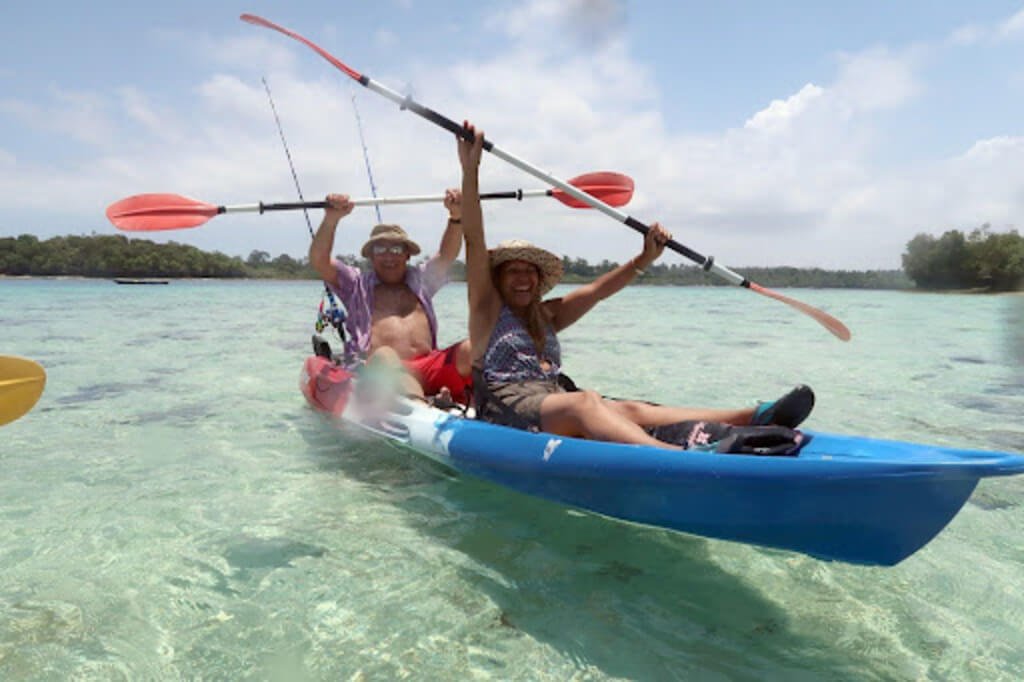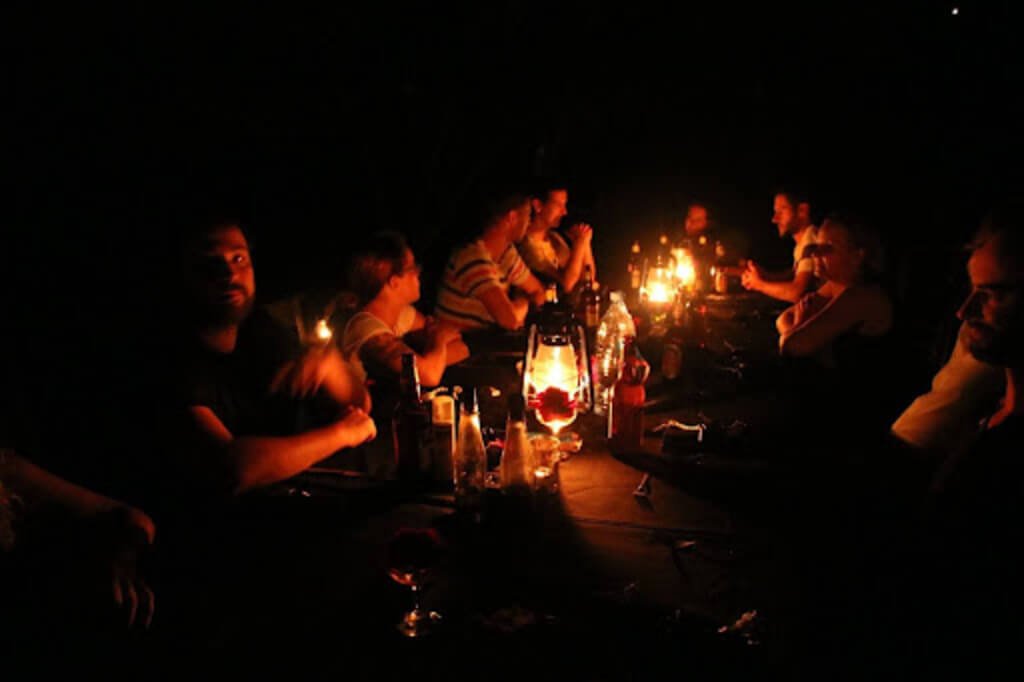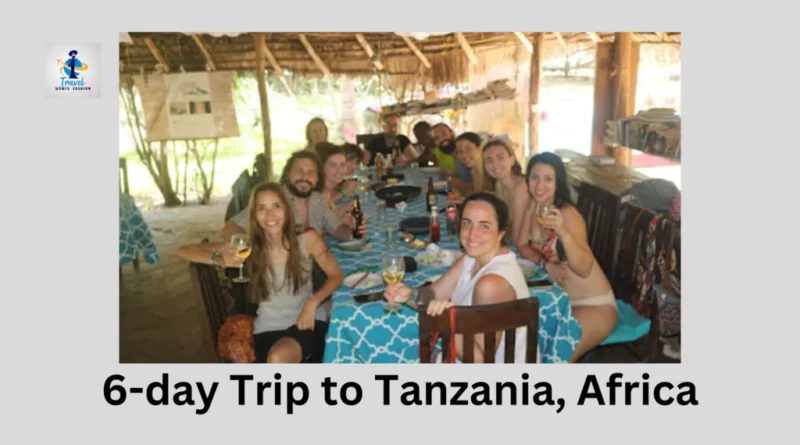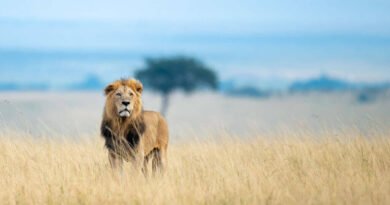6-day Trip to Tanzania, Africa: From The Serengeti To Zanzibar
Embarking on a Tanzanian escapade in August was a no-brainer. Teaming up with Fred, a French scuba enthusiast, our mission was clear: dive into the heart of East Africa’s diverse landscapes.
Planning was basic – a mix of online research and recommendations from fellow travelers. We snagged budget-friendly flights, opting for a 6-day exploration.
The goal? Seven days of unraveling Tanzania’s treasures, from the wildlife wonders of Ngorongoro Crater to the turquoise beaches of Zanzibar.
August, with its mild climate and peak wildlife activity, seemed the perfect window. Anticipating a blend of cultural immersions, scuba adventures, and untamed beauty, our bags were packed for an unfiltered Tanzania odyssey.
Here’s how our 6-day trip to Tanzania went.
Table of Contents
Day 1: Touchdown in the Serengeti
Day one, Fred and I land at Kilimanjaro International Airport. Not a big airport, but it did the job. Went for Serengeti Simba Lodge for a roof over our heads.
Opting for the wallet-friendly Serengeti Simba Camp set the tone for our pragmatic approach to accommodations. Canvas walls and wild sounds became our nightly serenade, a simple but immersive introduction to the African wilderness.
Launch at the camp’s restaurant showcased East African cuisine without pretense. The Spice-rubbed Grilled Fish offered a punch of local flavor, and Pilau Rice proved a hearty companion. No culinary masterpieces, just wholesome, straightforward sustenance.
The day unfolded into a safari game drive, bouncing along dusty tracks as the Serengeti revealed its animal kingdom. Zebras, lions, elephants, and giraffes paraded across the grassy stage, each sighting a brushstroke on nature’s canvas.

source: swahiligecko.com
Transportation was practical, roads bumpy but navigable, and villages along the way painted a picture of daily Tanzanian life. It wasn’t a luxurious start, but it was an authentic one.
As the day waned, stargazing on the open plains brought a celestial finale to our Tanzanian inauguration. Need some real backpacking tips for these walks through nature.
Back at the camp, the canvas walls whispered tales of Africa’s nocturnal life. The simplicity of the accommodation was its charm, allowing us to wake up to the primal soundtrack of the Serengeti.
Budget-wise, we were dancing on the frugal side, opting for middle-range choices. Day one’s spending tallied up, covering meals, accommodation, and the beginnings of our Tanzania adventure.
Day 2: Zanzibar – Beaches, Spice Tour, Manta Resort
Fred and I hoped on this short flight from Kilimanjaro, and as we landed, you could feel the warmth hitting you. It’s Zanzibar, you know – beaches, spice, and a whole lot of soul.
We set up camp near Makunduchi, a quiet spot by the beach, at the Ujamaa Beach Resort. Felt like a cozy beach house. It had that homely charm; you wake up, and the ocean is right there, whispering good morning.
Now, the food, oh boy! We tried the Spice-rubbed Grilled Fish, Coconut Bean Soup, and Pilau Rice. It’s like the island is throwing a party in your mouth. No five-star chefs, just local goodness that hits you just right.
The list of fun things to do in mainland Zanzibar is endless, but we started with the famous spice tours. This is an absolute must when you’re on this spice-rich island.
We joined a local spice tour, delving into the aromatic world of Zanzibar’s spices.
From cinnamon to cloves, the guide shared insights into the cultivation and uses of each spice. The experience was both educational and sensory, costing us around 25 bucks for the tour. If you want to learn, travel.
Here’s how to use travel as a genuine learning opportunity.
Post-spice immersion, we decided to cruise through the southern shores, driving through these local villages.
Throughout the day, we used local transportation – dala dalas (minibusses) and hired taxis for more remote locations.
The roads were a bit bumpy, but that’s part of the charm, right? You see kids waving, people selling foodstuff by the roads – real community stuff.

source: swahiligecko.com
As nighttime came, we headed to The Manta Resort for a unique stay. Fred and I wanted to try some luxury for once.
Perched on the Indian Ocean, The Manta Resort offers not just luxurious accommodations but also an underwater room. Yes, you heard it right – a room submerged in the crystal-clear waters, providing an unparalleled view of marine life.
The experience came with a price tag of around 500 bucks per night, but the memory is worth every penny.
Day two – it’s about beaches, good food, and the island’s soul.
But hey, we’re just getting started. Stick around for the real tales from the road.
Day 3: Stone Town’s Charm
Okay, day 3, we’re still in Zanzibar’s mainland and we’re seeking to explore the iconic, historic capital, Stone Town — a maze of narrow streets echoing centuries of history.
We took a 1h 30mn drive from Makunduchi to Stone town, via Nyerere Rd.
Accommodation for the day? Stone Town View Inn, strategically placed steps away from the historic district.
The journey from Makunduchi, long as it was, suddenly became 10x more fun once we stepped into the city and began to experience Stone Town’s unique architecture, with buildings boasting coral stone walls and intricately carved wooden doors.
Stone Town is like a living museum of the island’s rich past. The narrow streets, the vibrant markets, the colors – it’s a feast for the eyes.

source: swahiligecko.com
I can still picture myself wandering through the narrow, winding streets, lined with ancient buildings that seem to whisper stories of sultans, traders, and explorers.
What really caught me was the cultural diversity of Stone Town. It’s a place where African, Arab, and European influences converge, creating a unique and vibrant atmosphere.
We were so blessed to explore the labyrinthine alleyways, where I might stumble upon a hidden courtyard or a traditional Swahili
The Stone Town View Inn offered us cozy rooms with a terrace offering panoramic views of the skyline.
Visiting in the off-peak season meant fewer tourists, letting us dive into its charm without the hustle.
We got our food from local eateries, street-side cafes – that’s where it hit. I particularly enjoyed the Wali na Maharage (Rice and Beans), a simple yet comforting dish of rice cooked in coconut milk and kidney beans.

source: swahiligecko.com
Cost us about 20 bucks per meal per person – not bad for diving into the local flavors.
Stick around; from Pemba Island, we take a stop at Kibale Forest National Park, before heading over to the Ngorongoro National Park for more crazy wildlife exploration.
Day 4: Pemba Island – Uncharted Waters
We’re off to Pemba Island – a less famous Island in the Indian Ocean, dubbed the “Green Island.”
Drove for about 25 mns from the Stone Town Inn to the Abeid Amani Int Airport in Unguja, Zanzibar.
Got on a small plane to Pemba (45 mns flight cost about $112 — with the help of a travel agency), and as we flew over those turquoise waters, Pemba Island appeared on the horizon like a secret waiting to be uncovered. It was a 50-minute flight.
Touchdown at Pemba’s tiny airport was a breath of fresh air – no crowds, just tranquility.
Our spot for the day? Gecko Nature Lodge, a short drive from the airport, nestled near Makangale village. The road there was a mix of paved and dirt paths, winding through lush landscapes and local villages.

source: swahiligecko.com
The village life around here – simple, elegant coral stone houses with thatched roofs, each telling a story of the island’s traditional charm.
Now, let’s talk about food. We experienced local specialties like Ugali, a porridge-like dish made from maize, millet, or sorghum, mixed with water. Each bite was like a flavor explosion.
Our digs at Gecko Nature Lodge were airy bungalows with hammocks strategically placed for ultimate relaxation. The restaurant, overlooking the ocean, served up a mix of Swahili and international dishes. It wasn’t your five-star joint, but it had character – a place to unwind.
Spending for the day averaged around 180 bucks, covering accommodation, meals, and a mix of activities.
Speaking of which, we crammed in a whole bunch: visits to local markets, and here’s the kicker – a 2-hour group scuba diving trip with Swahili Divers.
Now, my buddy, Fred, is a seasoned diver, but not me. Fred joined a group of divers at Swahili Divers. Their two dives for the day were at the Shimba Hills, a popular dive site offering diverse marine life and stunning coral formations.
Shimba Hills:
- Dive sites: Manta Point and Coral Gardens
- Depth: 12-25 meters
- Difficulty: Novice to intermediate
- Highlights: Manta rays, coral gardens teeming with colorful fish, turtles, and dolphins (if you’re lucky!)
Me? I sipped on a local drink, watched the dive unfold from the beach – weird, but fun.

As the sun dipped into the Indian Ocean, the lodge transformed into a haven of tranquility. Evening bonfires, sharing stories with fellow travelers – it added a communal touch to our uncharted journey on Pemba Island.

Day three, filled with sea adventures and the spice of local life. Stick around; more tales are on the horizon.
Day 5: Exploring Dar es Salaam’s Delights
Alright, day 5, and we’re diving into the vibrant city life of Dar es Salaam.
We took a 2h30 mns flight from Pemba Island’s airport straight to Dar es Salaam. Cost us about $150 each (pricy, but it was the fastest route).
Our agenda for the day: a city walking tour with a side of street food tasting, immersing ourselves in the local flavors and culture. First, some rest at a local resort after the long flight.
Our afternoon began with a stroll through the bustling streets of Dar es Salaam. The city’s energy is infectious, with a mix of traditional markets, modern architecture, and the constant hum of daily life.
We opted for a local guide to navigate the city’s hidden gems, costing us around 30 bucks for the tour.

First stop – Kariakoo Market. This lively market is a sensory overload, with stalls brimming with fresh produce, spices, and local crafts. Our guide shared insights into Tanzanian daily life as we weaved through the market’s vibrant chaos. Entrance to the market was a mere 5 bucks.
Next on the list – a visit to the National Museum and House of Culture. This cultural gem offered a deep dive into Tanzania’s history, art, and traditions. Entrance fees were around 10 bucks, a small investment for a rich cultural experience.
Now, onto the highlight of the day – the street food tasting. We explored the city’s culinary scene, sampling local delights like mishkaki (grilled meat skewers), samosas, and vitumbua (rice cakes).

The flavors were authentic, and the experience allowed us to connect with the city’s culinary heartbeat. We tried foods like the Kachumbari(A refreshing tomato and onion salad, bursting with zesty flavors) and more.
Probably spent around 20 bucks for the entire street food adventure.
After indulging our taste buds, we took a leisurely stroll along the waterfront, enjoying the sea breeze and the city’s skyline. Dar es Salaam’s architecture reflects a blend of Swahili, Indian, and European influences, creating a visually captivating backdrop for our explorations.
Transportation for the day was mainly on foot, embracing the city’s walkable nature. The streets varied from bustling market alleys to more serene waterfront promenades, offering a diverse cityscape.
Day 5 – a city walking tour filled with cultural insights, culinary delights, and the rhythmic pulse of Tanzanian urban life.
Stick around; there’s more to uncover in the final chapter of our Tanzanian journey.
Day 6: Mnemba Island
Before leaving Zanzibar, we were eager to Visit Mnemba Island, a destination we’d heard so much about. We traveled to Mnemba Island from Der El Salaam by Ferry (boat), a 2h 40mn trip.
Although exhausted, our goal was to pack up the day with as much exploration as our tired legs could allow.
Our options:
- Pristine shores of Mnemba Island.
- The historic sites of Prison Island, the lush wonders of Jozani Forest, and
- The iconic dining experience at The Rock.

Our Mnemba adventure kicked off with a short boat trip from Nungwi Beach. The ride cost around $40 (USD) and took about an hour, but trust me, it was a scenic cruise with dolphins frolicking alongside the boat.
The ocean breeze whipping through my hair and the salty spray on my face – pure bliss!
Our guide for the day was a local legend. He knew every nook and cranny of the reefs, making us feel safe and excited for the underwater world ahead.
First up, snorkeling! We donned our gear and plunged into the crystal-clear waters. It was like swimming through a living aquarium!
Clownfish peeking out of anemones, vibrant parrotfish nibbling on coral, and graceful stingrays gliding past – it was mind-blowing! We even spotted a majestic sea turtle munching on seaweed – seriously, coolest. turtle. ever.
After all that underwater excitement, our tummies were rumbling. We beached it on a sandbank on the shores of Nungwi beach, the water so shallow it barely reached our knees.
The crew whipped up a delicious feast of fresh seafood grilled to perfection, with tropical fruits and salads for a refreshing touch. Lunch with a view of endless turquoise horizons? Doesn’t get much better than that!
Day 6 was all about the water experience.
I’d definitely recommend Zanzibar if you’re going on holidays with family.
Rounding off…
There you have it, 6 days of everything. I should write a book, but I’ll just leave it here for now. Hope you enjoyed this tour. For us, the experience was unbelievably moving and life-changing.
Traveling to Africa and specifically to Tanzania will never leave you the same. There’s Something inexplicably unique and special about nature, the culture, food, history, the waters, the beaches, the wildlife, the forests, the people, the resorts, and the communities.
If you’d like to visit Tanzania in 2024, here’s a complete guide with simple steps to plan your trip to Africa.
Image sources: swahiligecko.com



